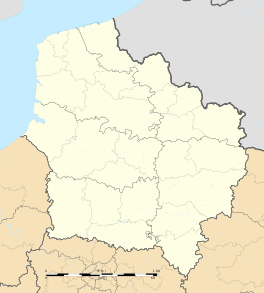Picquigny
| Picquigny | |
|---|---|
|
The church | |
 Picquigny | |
|
Location within Hauts-de-France region  Picquigny | |
| Coordinates: 49°56′42″N 2°08′41″E / 49.945°N 2.1447°ECoordinates: 49°56′42″N 2°08′41″E / 49.945°N 2.1447°E | |
| Country | France |
| Region | Hauts-de-France |
| Department | Somme |
| Arrondissement | Amiens |
| Canton | Picquigny |
| Intercommunality | L'Ouest d'Amiens |
| Government | |
| • Mayor (2001–2008) | José Herbet |
| Area1 | 10.31 km2 (3.98 sq mi) |
| Population (2006)2 | 1,393 |
| • Density | 140/km2 (350/sq mi) |
| Time zone | CET (UTC+1) |
| • Summer (DST) | CEST (UTC+2) |
| INSEE/Postal code | 80622 / 80310 |
| Elevation |
11–107 m (36–351 ft) (avg. 17 m or 56 ft) |
|
1 French Land Register data, which excludes lakes, ponds, glaciers > 1 km² (0.386 sq mi or 247 acres) and river estuaries. 2 Population without double counting: residents of multiple communes (e.g., students and military personnel) only counted once. | |
Picquigny is a commune in the Somme department in Hauts-de-France in northern France.
Geography
Picquigny is situated at the junction of the N235, the D141 and D3 roads, on the banks of the Somme River, some 8 miles (13 km) northwest (and downstream) of Amiens. A railway station also serves the town.
Population
| 1962 | 1968 | 1975 | 1982 | 1990 | 1999 | 2006 |
|---|---|---|---|---|---|---|
| 1195 | 1309 | 1322 | 1381 | 1397 | 1386 | 1393 |
| Starting in 1962: Population without duplicates | ||||||
History
Already established as a Gallic settlement before the Romans arrived, a Gallo-Roman cemetery gallo-romain was discovered in 1895 in the area known as Les Vignes.[1]
Known through the ages by various names, in 942 as Pinquigniacum, Pinconii castrum in 1066 and Pinchiniacum in 1110, then as Pinkeni, Pinkinei and Pecquigny .[2]
After the defeat of the Huns at Lihons-en-Santerre, the inhabitants of Amiens, who had helped the barbarians, took refuge in the castle of Picquigny, to hide from the vengeance of Dagobert, where they were then besieged by him.[3]
On 17 December 942, Arnulf I, Count of Flanders and William I, Duke of Normandy came to Picquigny to sign a peace treaty. They met on a small island in the Somme, having both left their armies behind. After the meeting, William left but was then assassinated by Arnulf’s supporters.
As early as the 14th century, the town had commune status and a county judge. In 1307, several Templars, were arrested and imprisoned in the dungeons of the château by order of Philip IV of France,
On 29 August 1475, with the Treaty of Picquigny, Louis XI brought to an end the Hundred Years' War. The French king had to pay King Edward IV an annual sum of fifty thousand crowns.
In 1547, Henry II of France established a market, on every second Monday of the month.
Main sights
- The Château. Built around the beginning of the 11th century and rebuilt over the following centuries. It was severely damaged during World War I. The vestiges are still picturesque and imposing, nevertheless. Outside of the ramparts, there are other medieval buildings : a prison, a kitchen, two cellars, latrines and the Pavillon Sévigné
 The ruins of the chateau
The ruins of the chateau_1.jpg) The kitchen fireplace
The kitchen fireplace Louis Duthoit (1807-1874) - Château de Picquigny
Louis Duthoit (1807-1874) - Château de Picquigny
- The church. Originally the chapel to the château, is found behind the ruins of the old chateau, inside the ramparts. The roof was destroyed in a fire at the start of the 20th century.
.jpg) Steps to the crypt, found behind the baptismal font
Steps to the crypt, found behind the baptismal font_1.jpg) The crypt of the church
The crypt of the church
See also
References
- ↑ L. Ledieu - « Dictionnaire historique et archéologique de la Picardie », Tome III, Canton de Picquigny, page 197 (1919, reprint Editions Culture et Civilisation, Bruxelles, 1979)
- ↑ "Recueil des monuments inédits de l'histoire du tiers état- chartes, coutumes, actes municipaux…" Par Louandre, Charles Léopold, 1812-1882, Thierry, Augustin, 1795-1856, Augustin Thierry, États généraux, France, Tiers État
- ↑ Grandes Chroniques de France
External links
| Wikimedia Commons has media related to Picquigny. |
- Picquigny on the Quid website (French)
